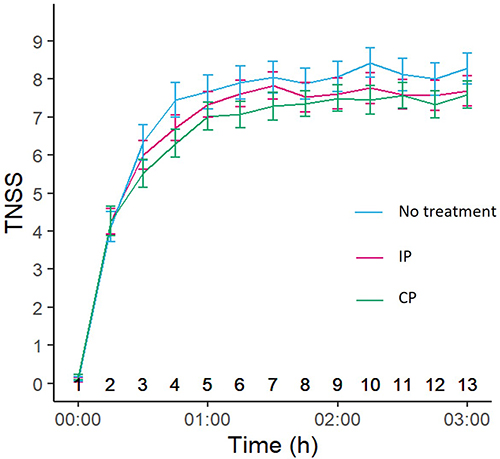Purpose: Nonpharmacological, barrier-forming nasal sprays are used to manage symptoms of allergic rhinitis. We aim to evaluate the safety and effectiveness of Callergin (investigational product, IP), a nasal spray containing barrier-forming iota-carrageenan, in the treatment of allergic rhinitis (AR).
Methods: In this randomized, controlled, crossover trial, adults with grass pollen allergy underwent a treatment sequence with IP, VisAlpin (comparator product, CP), and no treatment in random order. Treatment blocks consisted in prophylactic administration of the assigned treatment or no treatment, followed by a 3-hr allergen exposure, and were separated by a washout period of 7 days. Primary endpoint was a mean change from baseline in “Total Nasal Symptom Score” (TNSS, sum of rhinorrhea, itching, sneezing, and congestion scores) over 3 hr, recorded every 15 min during the challenge period.
Results: A total of 42 participants underwent randomization. Exposure to grass pollen for 3 hr induced a notable TNSS increase from baseline in all participants at all times. Mean TNSS change from baseline over 3 hr was lower when participants received IP compared to no treatment, although the difference did not reach statistical significance (untreated 6.96 ± 2.30; IP 6.59 ± 1.93; difference 0.37 points [95% CI (confidence interval) − 0.17 to 0.91]; p=0.170). In a post-hoc analysis, mean TNSS at 3 hr was significantly reduced after IP treatment compared to no treatment (untreated 8.29 ± 2.64; IP 7.70 ± 2.56; difference 0.60 points [95% CI − 0.10 to 1.29] p=0.028). While all individual nasal symptoms contributed to this effect, rhinorrhea (p=0.013) and congestion (p=0.076) contributed most. Consistently, nasal secretion weight was slightly reduced with IP treatment (p=0.119). IP was safe and well-tolerated, with similar incidence of adverse events across treatment groups.
Conclusion: Prophylactic treatment with the iota-carrageenan nasal spray IP is safe, well-tolerated, and alleviates nasal allergy symptoms in adults with grass pollen-induced AR.



No comments:
Post a Comment